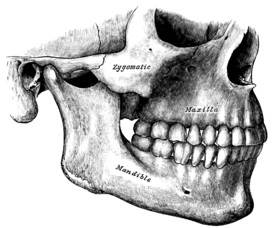Orthognathic surgery
| Orthognathic surgery | |
|---|---|
| Intervention | |

Relationship between mandible and maxilla
|
|
| ICD-9-CM | 76.6 |
Orthognathic surgery (/ˌɔːrθəɡˈnæθɪk/ OR-thəg-NATH-ik) is surgery to correct conditions of the jaw and face related to structure, growth, sleep apnea, TMJ disorders, malocclusion problems owing to skeletal disharmonies, or other orthodontic problems that cannot be easily treated with braces. Originally coined by Harold Hargis, it is also used in treatment of congenital conditions like cleft palate. Bones can be cut and re-aligned, then held in place with either screws or plates. Orthognathic surgery can also be referred to as corrective jaw surgery.
It is estimated that nearly 5% of the UK or USA population present with dentofacial deformities that are not amenable to orthodontic treatment requiring orthognathic surgery as a part of their definitive treatment. Orthognathic surgery can be used to correct;
Orthognathic surgery is a well established and widely used treatment option for insufficient growth of the maxilla in patients with an orofacial cleft. There is some debate regarding the timing of orthognathic procedures, to maximise the potential for natural growth of the facial skeleton. Patient reported aesthetic outcomes of orthognathic surgery for cleft lip and palate appear to be of overall satisfaction, despite complications that may arise. A potentially significant long-term outcome of orthognathic surgery is impaired maxillary growth, due to scar tissue formation. The Cochrane collaboration released a systematic review comparing traditional orthognathic surgery with maxillary distraction osteogenesis. The review found both procedures effective, but suggested distraction osteogenesis may reduce the incidence of long-term relapse. It should be noted that the quality of evidence was rated low, as only one study was included.
...
Wikipedia
